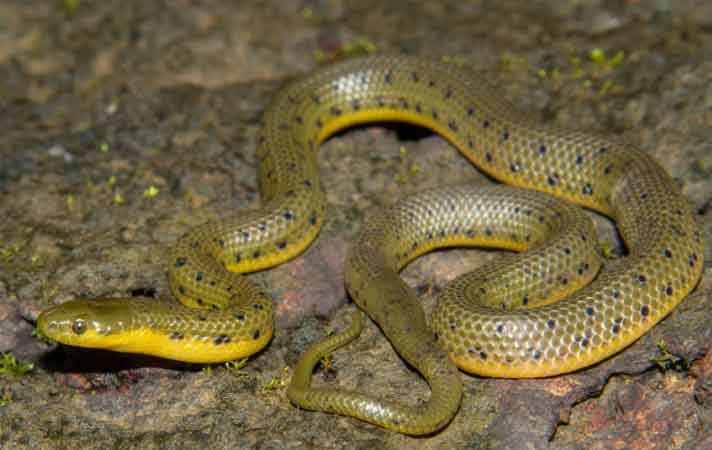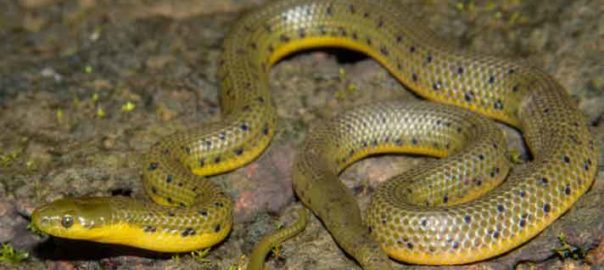Quick Notes
- A new species of aquatic snake has been discovered in the Western Ghats. It is endemic to India.
- The snake prefers to live in fresh water streams.
- Juveniles and adults have different coloration.
- The snake was earlier mistaken to be Olive forest snake but was correctly identified after DNA testing to be a new species.
A new species of burrowing aquatic snake has been discovered in the northern part of the Western Ghats. The Aquatic Rhabdops species named Rhabdops aquaticus, was discovered after eight long years of research and is endemic to India found in Maharashtra, Goa and northern Karnataka. It was earlier mistaken to be an Olive forest snake.

The discovery is the result of a collaborative effort of scientists from National Centre for Biological Sciences (NCBS) in Bangalore, Natural History Museum (NHM) in London, Centre for Ecological Science (CES), Indian Institute of Science in Bangalore, Indian Herpetological Society (IHS) in Pune, Wildlife Institute of India (WII) in Dehradun, Kerala Forest Research Institute (KFRI) in Peechi and College of Veterinary Science (CVS) in Pookode.
Read More: New Snake Species Discovered in Gujarat
Varad Giri, a researcher from NCBS who played a major role in the discovery said, “We have named this new species after its aquatic nature as the adults are mostly associated with fresh water streams in the forest and young ones are mostly seen in water logged conditions, mostly on rocky plateaus.”

This species is nocturnal, chiefly aquatic and seen foraging underwater. The young ones and adults are different in colour. This colour variation with growth may be due to their preference of habitat.
This species is presently known to live in a few locations. In Maharashtra, it was seen in the Koyna region, the Chandoli National Park, between Kolhapur and Sangli districts, Baraki in Kohlapur district and Amboli in Sindhudurg. In north Karnataka, it was identified from Castle Rock in Uttar Kannada and some areas in Goa. In Maharashtra, it is spotted in plateaus where water logging occurs. The largest known specimen is 950mm in length. It is non-venomous.
Read More: Blind Albino Crab Discovered in Meghalaya
Mistaken Identity
Earlier the species was considered as Olive Forest Snake owing to its similarities with it in characteristics and distribution. However, the aquatic nature of this species and the detailed study of the DNA and morphology of the both the specimens (the historical (Olive Forest Snake) and the new ones from various locations in the Western Ghats) helped the scientists arrive at the conclusion that this was a new species altogether. The Olive Forest Snake discovered in 1863 in Wayanad district of Kerala is seen in the two states of Kerala and Tamil Nadu.
The findings of the research team and their detailed study confirmed the distinctiveness of the species and the results were submitted to a scientific journal Zootaxa published recently.
Significance of the discovery
Dr. Varad Giri says that the discovery is important in establishing the diversity of species found in the northern Western Ghats, which is slowly getting destroyed due to developmental activities. The discovery of this species has once again brought the focus on the need to conserve the natural habitat of the Ghats consisting of rocky plateaus and forest streams.
Read More: Are There Any Poisonous Frogs In India?
Yet another outcome of the discovery is the need to reassessment for IUCN criteria. Further studies need to be done to identify their exact population but initial evaluation found 40 individuals in one location.
“There is good distribution of these species, especially in Maharashtra. So far the International Union for Conservation of Nature (IUCN) had identified the Olive Forest Snake all along the Western Ghats. What we found is the distribution of snake species is different in the northern and southern parts of the Western Ghats and there is a need of reassessment for IUCN criteria for this new species,” said Dr. Giri.






Well this is very interesting that even though we have access to these places yet new species are being discovered, think about north east India, what it has to offer is tremendous in term of places yet to be explored.